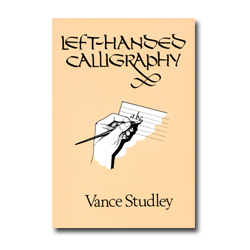Left-Handed Writers
There is a common misconception that fountain pens are problematic for left-handers. The truth is that lefties love fountain pens. In fact, left-handers tend to own fountain pens at a higher rate than their percentage of the population might otherwise indicate.
In a bygone era when fountain pens were often equipped with flexible or soft nibs, there were some challenges for lefties who push, rather than pull, a pen across the page. If those tines separate in the wrong direction, ink goes sputtering across the paper, onto the desktop, and anything else within range. Modern fountain pens have solved that problem by providing rigid nibs that write smoother for all kinds of writers, lefties included. It sounds counter-intuitive, that a soft nib is scratchier than rigid one. However, the stiff tines of a rigid nib don't separate easily as pressure is applied, making for an overall smoother writing experience.
There is still one significant issue facing most left-handed fountain pen users. When you're writing from left to right, such as with the English language, left-handed writers need to avoid dragging their hand through the drying ink. Lefties are clever and tend to avoid this instinctively. It doesn't even cross their mind that they've developed a strategy to get along in a predominantly right-handed world.
The photos below illustrate some of the various writing styles utilized by left-handers. There are as many writing styles as there are left-handed writers, but one of the photos should come close. Knowing what kind of left-handed writer you are helps us when tuning your pen. With a few simple adjustments, most pen and nib combinations can be made to write well. However, if you have an unusual grip or paper angle, please let us know. We'll do our best to accommodate you.

Left-handed Calligraphy
By Vance Studley
Left-handers are just as likely to take up calligraphy as right-handers, but virtually all the instruction books are written with the right-handed practitioner in mind. Left-handed Calligraphy, by noted calligrapher and educator Vance Studley, presents an introduction to calligraphic scripts, including Italic and Cursive, with an emphasis on positioning and layouts that will make sense for southpaws. The little arrows all go in the proper direction!


An article was written for the PENnant about left-handed writers. 'Notes from the Nib Works'
Left-hand Writers revised 6/8/04
While just over ten percent of Americans are left handed, they represent a disproportionate number of fountain pen users (at least from the perspective of The Nib Works.) This may at first glance seem strange, given the difficulty that they have using fountain pens. But, on further thought, this may not be so strange. Faced with a difficult situation, left-handers seem to push ahead and embrace the challenges that are thrown their way... Click here to read more.
